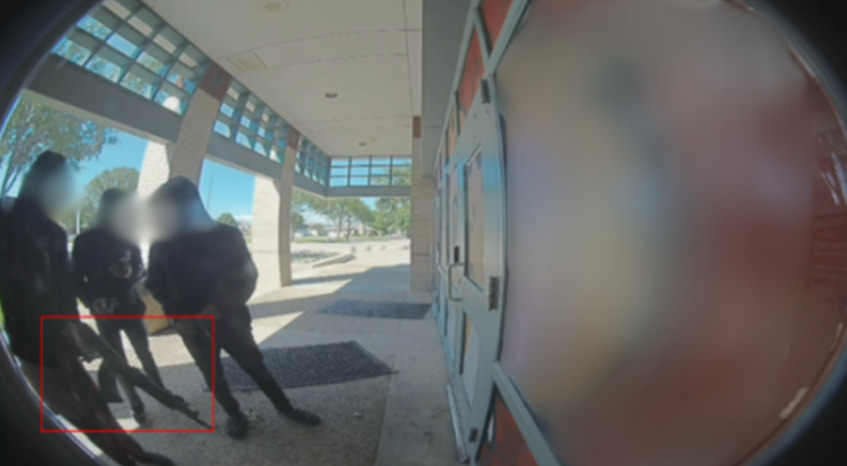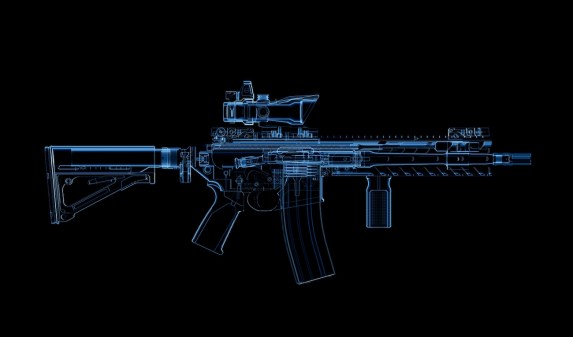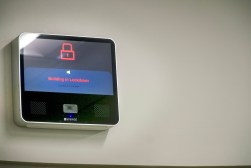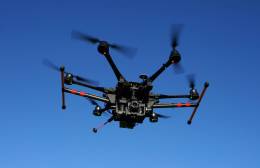Schools are buying AI software to detect guns. Some experts say it’s a mistake

As schools across the country pursue artificial intelligence to combat gun violence on their campuses, a product from a company called ZeroEyes is finding hundreds of customers. But some school safety experts question whether the technology’s benefits warrant schools spending their limited funds.
The Pennsylvania tech firm offers AI-powered gun-detection software it bills as a “proactive solution” to protect children from gun violence on public school grounds. In an interview with StateScoop, ZeroEyes executives attributed the popularity of their product among schools to savvy marketing and the novelty of their AI models.
The company’s practice of lobbying state legislators may also help bring in new business.
In several states where ZeroEyes has lobbyists registered, lawmakers have funded school safety purchases, sometimes issuing requirements so specific that ZeroEyes is the only legal competitor, despite there being other similar products on the market.
In districts that aren’t receiving state funding, ZeroEyes occasionally offers discounts on the product, resulting in cash-strapped schools forking over funds that might have otherwise gone toward improving their educational offerings.
When asked, ZeroEyes provided information about one incident in which its technology has provided an early warning. In that incident, the company said, its system detected a minor armed with an AK-47 rifle on an elementary school campus in Texas. No shots were fired. ZeroEyes declined to provide additional information, citing the school’s request to remain anonymous.
The technology has also triggered several false alarms that prompted law enforcement response, lockdowns and student panic. Some school safety experts told StateScoop the company is misleading schools and states into spending money on a product that can’t do what it claims.
‘Proactive and actionable’
ZeroEyes cofounder Sam Alaimo told StateScoop that his company’s technology is deployed in 43 states, including in hospitals, sports arenas, malls and schools. The company was founded in 2018 in response to the school shooting at Marjory Stoneman Douglas High School in Parkland, Florida, that left 17 dead.
ZeroEyes’ software is layered on top of schools’ video surveillance systems, and video feeds are fed to AI models that have been trained to spot firearms. If a firearm is detected, a human employee at ZeroEyes’ 24-hour operations center gets an alert and determines the accuracy of the detection. ZeroEyes then alerts school administrators and law enforcement officers of the situation to respond appropriately. For schools that do not have a school resource officer on school grounds, the law enforcement response can take several minutes.
Aegix Global, ZeroEyes’ Utah distributor, claims in a September 2023 proposal to the Park City, Utah, School District that “[t]he ZeroEyes platform is the most proactive and actionable early-warning system on the market, allowing users to ‘Save time, save lives.’”
Chad Marlow, a senior policy counsel at the American Civil Liberties Union who researches public safety technologies, told StateScop that ZeroEyes’ use of the word “proactive” in its marketing was misleading. A proactive technology, he said, would detect and prevent a potential threat before it made it onto school campuses, while a “reactive” technology requires the threat to be present for a response.
Alaimo said the incident at the Texas elementary school is just one example of how the technology is proactive even if it doesn’t stop guns from arriving on school campuses, per Marlow’s definition.
“No shot was fired. We dispatched, they apprehended the individual. So I wonder, is that not proactive?” Alaimo said, adding that ZeroEyes would never claim that its technology would prevent a mass shooting. “Even then, I can’t say we’ve averted a mass shooting, nor would I ever, but I can say that I can’t think of another definition for proactive that doesn’t include this scenario right here, where we actually got the dispatch with an actual AK-47.”
Michael Dorn, executive director of Safe Havens International, a nonprofit that specializes in offering safety assessments to K-12 schools, told StateScoop that a school receiving an alert as soon as a weapon is brandished doesn’t equate to preventing someone from firing that weapon, as violence tends to happen quite quickly.
“A lot of the active shooter events I’ve worked on, it’s nine seconds from when the gun comes out ’till they’re done shooting,” he said.
Dorn led the team that conducted the school safety and emergency preparedness assessment of Marjory Stoneman Douglas High School following its deadly 2018 shooting. In his 40 years as a school safety expert, he’s performed school safety assessments in the wake of 28 active shooter events on school campuses.
“One shooting I worked out in Oregon, he shot 25 people in 60 seconds,” Dorn said. “So in that case, a technology like ZeroEyes doesn’t help you prevent it at all. It can speed up the response to it, which could save lives if you’ve got people injured, and maybe you cut 60 seconds or 40 seconds or 30 seconds off the response time, which is probably about all you’ve got to cut.”
The Department of Homeland Security called ZeroEyes’ “proactive” claim into question in a 2023 report. Evaluators noted that while ZeroEyes’ tech “can alert first responders within seconds of a brandished weapon, it does not guarantee threat prevention.”
“ZeroEyes gets the first alert notification and initiates the dispatch, if necessary, but takes three to five seconds to notify first responders of the incident,” the report read. “Evaluators wonder if these critical seconds before ZeroEyes alerts first responders may result in the system taking too long to be as effective in detection and alerting. ZeroEyes developers point out, however, that there is a trade-off between timeliness and their false positive rate: they cite the additional review by a human as crucial to low false positives.”
But even human review is fallible, and ZeroEyes has triggered several false alarms. A shadow cast by a student’s arm triggered a false alarm at a high school in Texas in October 2023, sending the school into lockdown, and sending students, their families and friends into panic. ZeroEyes tech triggered a lockdown and police response at St. John Fisher University in Rochester, New York, in June after it picked up two prop guns that were being used during a theater production rehearsal.
Guy Grace, who chairs the Partner Alliance of Safer Schools’ technology advisory committee, a nonprofit that develops school safety guidelines, said whether or not a technology can be labeled as proactive depends also on a school’s video surveillance ecosystem.
“If the school district had the right cameras in place to support that type of AI, yes, I would agree [ZeroEyes’ technology] would be very proactive,” said Grace, who also served as director of security and emergency planning for Littleton Public Schools near Denver, Colorado, for more than 30 years.
“However, the key is you can’t be proactive with the way a lot of schools are right now because of the cameras that are in place,” he continued. “That’s the problem in our country, is we have a lot of schools trying to do the right thing by being very proactive. But we, as school officials — and I’ve done the same thing — may not have really done the assessments to make sure that we can support that technology.”
Last year, there were 82 shootings on school campuses, the highest number of school shootings in the period of a year to date, according to CNN’s school shootings database. As school shootings have increased in frequency, so too have technologies that purport to protect children, Marlow said.
“It’s not just the fact that their product does nothing to advance kids’ safety, but it actually hurts kids,” said Marlow, who also sits on a DHS school safety advisory board. “Surveillance hurts kids, false senses of security hurts kids. False alarms, false positives for weapons and bombs hurts kids.”
ZeroEyes’ Alaimo called Marlow’s assessment “ludicrous.”
“And it does seem very reckless to make a claim like that without evidence, without seeing the actual detections, without knowing that that AK-47 didn’t make it through that doorway into a hallway,” he said.
‘The highest standards’
In January, ZeroEyes reported a year-over-year revenue increase of 300%. While company executives said their marketing campaigns have been a key part of this success, ZeroEyes’ widespread lobbying efforts are also helping to put the technology on more campuses.
More than a dozen ZeroEyes lobbyists are registered in state legislatures. The lobbying efforts have resulted in at least five state legislatures passing funding bills that create funds that school districts can apply for and spend on school safety measures. In some states, the terms of the funding bills are more generic and allow districts to use the funds they receive on a variety of measures that would increase school safety, like metal detectors or bulletproof windows.
Other funding bills are more restrictive on how the money can be spent. In April, the Kansas state legislature attempted to pass a school safety funding bill that would have given schools a piece of $5 million in funding — but only if they invested in a gun detection technology that had received a special anti-terrorism technology designation from the U.S. Department of Homeland Security. ZeroEyes received that designation as part of the SAFETY Act, a 2002 law meant to encourage the development and deployment of anti-terrorism technologies.
At the time the Kansas bill was being heard, ZeroEyes was the only company whose AI gun detection technology had the special designation. Just days after the bill passed in April, Gov. Laura Kelly vetoed the line item that restricted how the school safety funds could be spent based on the designation, citing concerns that it could have eliminated “nearly all potential competition.”
Other states — including Iowa, Michigan, Missouri and Utah — passed legislation over the last two years with similar wording regarding the anti-terrorism designation. Prior to its passage in April, Iowa’s bill was amended so that the anti-terrorism designation isn’t required until next July 1, allowing ZeroEyes’ competitors time to get it.
ZeroEyes Chief Strategy Officer Kieran Carroll in February demonstrated ZeroEyes’ technology during an informational hearing before the Kansas state legislature. The Kansas Reflector reported that such informational hearings are different from regular hearings in that other vendors or lobbyists with differing opinions aren’t allowed to speak.
State Rep. Kristey Williams, chair of the Kansas House’s K-12 Budget Committee and architect of the school safety bill, told StateScoop that ZeroEyes approached the legislature with its product and that its accreditations, like the anti-terrorism designation, had inspired the bill’s language.
“They came to us and it was a great idea,” Williams said. “We don’t always know that there’s AI technology — we wouldn’t know that unless they brought it to us. … We want only the highest standards for our kids, and so we want an accredited, verifiable type of technology, and that AI technology is able to detect over 2,000 different permutations of a gun, and then it’s sent to a team of professionals that are trained to respond immediately within two to three seconds whether or not it’s a real gun or not, it’s a real risk or not.”
Carroll tells a different story of how his company started in Kansas.
“I think initially we met legislators and policymakers from Kansas at an American Legislative Exchange Council meeting,” he said. “I believe they invited us to come speak and present to the legislature when they started throwing appropriations down. I think, legally at that point, we had to hire lobbyists just so that we could cover our bases and make sure that we were doing everything above board. Do I think that they went overboard on the number of specifications that they listed? Yeah, I personally do think that. But that was the prerogative of the legislature.”
The American Legislative Exchange Council is a nonprofit known for drafting and promoting model state legislation that advances conservative interests. Journalists and civil rights groups have accused the council of embedding corporate interest into state laws. It’s been behind educational policy pushes like universal school choice, a Republican platform policy that would make taxpayer-funded vouchers or scholarships available to all children, regardless of household income, for use at public or private schools. The group has also endorsed the expansion of facial recognition technologies in schools.
ALEC also published a draft model policy on its website on July 24 that would “provide a state department of education with the ability to utilize existing funds to enter into a contract that provides AI firearm detection software to schools.” The model policy includes a requirement for the DHS anti-terrorism designation.
In an email, ZeroEyes confirmed it’s “a private sector member of ALEC that educates members on the company’s policy concerns.”
Alaimo said that he thinks of the anti-terrorism designation as “a baseline accreditation or a common sense standard.” He said parents and legislators may be more likely to trust a technology that has been vetted by a third party like the Department of Homeland Security.
But, he said, the company’s lobbying is only educational.
”We don’t write legislation. We educate legislators just like we do superintendents, and the requirements they put in there didn’t guarantee anything to ZeroEyes. It doesn’t make a school buy anything from ZeroEyes,” Alaimo said. “Right now AI is the Wild West. The more people who are familiar with the technology, the more people who have vetted it, the more certifications, I think the more trustworthy the technology.”
With some exceptions, Kansas requires that agency contract awards follow competitive bidding. Williams said that after Kansas’ funding bill passed, but before it was finalized, other vendors reached out. Motorola, which sells AI technology for detecting concealed weapons, told the legislature its product had received the anti-terrorism designation, she said.
“We changed it so that it would be available to other vendors,” Williams said. “We originally thought that ZeroEyes would be the very best vendor, and so we wanted that, but then we realized there were other vendors that met the requirements. And so we opened it up to any of those.”
Economy of scale
“Protecting schools from gun violence is the reason ZeroEyes was created, and it’s still the mission our team is most passionate about,” the company’s website reads.
Marlow said addressing the distinctly American problem of school shootings could be done valiantly, but that in the case of ZeroEyes, it’s not. He said the company’s marketing tactics, including use of the word “proactive,” are a big part of what drives schools to buy.
According to invoices obtained through public records requests, ZeroEyes technology costs school districts as much as $130,000 per year, depending on how many cameras are used.
The East Union School District in Afton, Iowa, which includes just 500 students at two schools, in February signed a one-year contract with ZeroEyes for $27,500. It includes $22,500 to monitor up to 38 cameras and a one-time set-up fee of $5,000.
The small Mount Pulaski Community Unit School District No. 23 in rural Illinois last September signed a five-year contract with ZeroEyes for $38,280 per year for up to 116 cameras. ZeroEyes waived its one-time set-up fee.
The Iberville Parish School District in Plaquemine, Louisiana, which includes 4,000 students at nine schools, last November signed a five-year contract with ZeroEyes for $687,000. It includes $134,400 per year to monitor up to 800 cameras, and a $15,000 set-up fee.
Utah’s Park City School District, which has 4,500 students at 12 schools, pays $109,200 annually for ZeroEyes’ software to monitor its 650 cameras.
These varying costs, said Carroll, the ZeroEyes chief strategy officer, reflect an “economy-of-scale” pricing model, an industry standard in which customers that purchase more licenses pay less per license.
But economy of scale doesn’t explain some of the company’s pricing disparities across sectors. While the small Mount Pulaski district pays $330 per camera per year, and the Michigan State Capitol pays ZeroEyes $396 per camera per year to monitor its 100 cameras, the Southeastern Pennsylvania Transportation Authority paid $420 per camera, for up to 300 cameras, during its yearlong pilot of the technology last year.
“In general, I think we do try to give school districts a discount if we can. … The school districts that really struggle, our inner city districts that have maybe financial issues, or rural districts, just don’t have the tax base to support something like this,” Carroll said. “So we think about it from an equity perspective and making sure that all kids have some sort of access to the next generation proactive security measure.”
‘An immediate solution’
Tim Kuehl, superintendent of the East Union School District in Afton, Iowa, told StateScoop that his district came into contact with ZeroEyes not through lobbying or the company’s marketing — but instead, an Afton community member shared information about the technology with school officials. Kuehl said the district engaged the company, and after a demonstration, officials were swayed and entered into a contract.
“We’re a smaller district, we don’t have armed security,” Kuehl said. “We have very supportive local law enforcement, but they’re not there 24/7 by any means. So, it seemed like a really good tool to just help monitor everywhere we have cameras all the time if a weapon would be present.”
This lack of resources is a core component of what drives schools to turn to technology to help mitigate the threat of school shootings. But, Marlow, with the ACLU, said technology should not be the only intervention for protecting kids from gun violence in schools.
“In our modern society, people love the idea of technological fixes, they love the idea that AI and technology are going to enable us to solve problems we couldn’t solve before,” he said. “And that’s why if you get a choice between ZeroEyes’ artificial intelligence-driven weapon detection, and let’s just hire another mental health counselor, people are super excited about the technology even though the mental health counselor has been shown to actually have a positive impact.”
Amanda Klinger, director of operations at the Educator’s School Safety Network, a nonprofit that provides educators with school safety training and resources, agreed that the idea of a quick fix is attractive.
“Our public schools are not infinitely resourced, and frankly most of them are actually under-resourced for what they need to do. And so that’s what makes it so much more difficult to see folks spending money and spending non-negligible sums of money on these tools, on hardware and software tools that we really don’t know their efficacy,” she said.
“I think what’s frustrating about that is we have behavioral threat assessment and management. It is an evidence-based program,” she continued. “It has been tested and field tested and rigorously tested again and again, and we know that it can prevent violence in our schools, but it’s not as flashy or as interesting or as easy to sell as ‘Buy this thing, hang it up.’”
Many experts say mass shootings are a multifaceted issue with no single remedy. In a journal article last year, Harvard researchers wrote that “[t]he assumption that mass shootings are driven solely or even primarily by diagnosable psychopathology stretches the limits of mental health expertise.”
Gun control also offers no clear, single solution. Partisan debates have overtaken the idea, with gun rights advocates arguing that criminals and particularly those with ill intentions don’t abide by the law anyways.
ZeroEyes cofounder Alaimo said that until a panacea is presented, the company’s technology is the next best thing.
“We should be talking about gun laws. But again, there’s no immediate solution to that one,” Alaimo said. “And we can offer thoughts and prayers, and that’s good, but there’s no immediate solution to that. We have an immediate solution right now to literally do something about the problem.”
Grace, of the Partner Alliance of Safer Schools, said that while the technology is promising, it should be thought of as just one component of how to make schools safer.
“There’s a much bigger picture here that we need to do in schools, other than just one or two components,” Grace said. “Any kind of technology — anything from the simple thing of a lock to complex AI or cameras — the important aspect is everything we’re talking about [are] tools for people. … Whether it’s a passive tool or it’s running in the background, it’s a tool to empower that learning environment.”
And most school district leaders, like East Union’s superintendent, hope to avoid dangerous situations altogether.
“I think we just look at it as if it’s something like an insurance policy, “ said Kuehl, “that you’re happy to have but you hope you never have to use, you know?”
Corrected August 22, 2024: The American Legislative Exchange Council was originally referenced as a lobbying group. The story was changed to show that it is a nonprofit.






